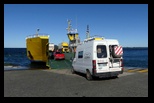
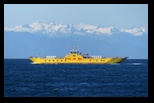
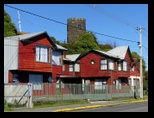
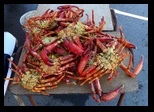
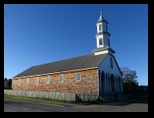

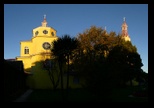
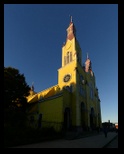
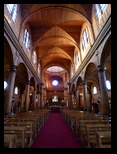
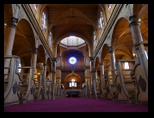
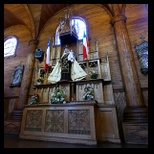
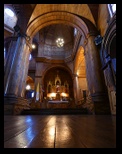
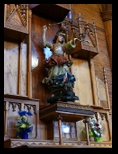
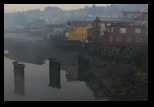
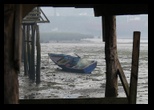
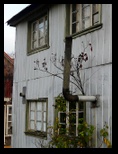
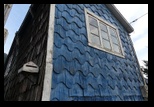
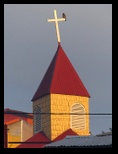
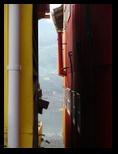
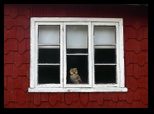
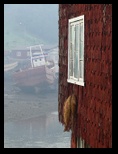
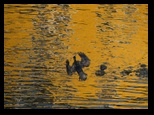
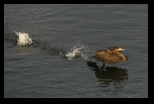

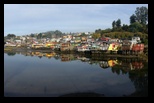

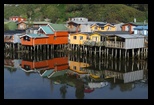
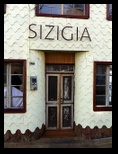
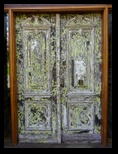
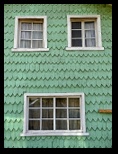
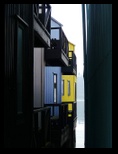
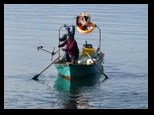
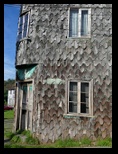
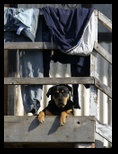
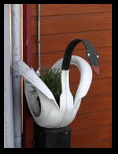
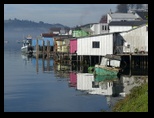

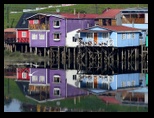
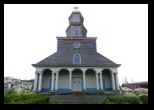
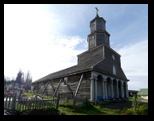
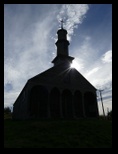
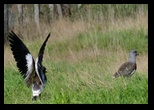
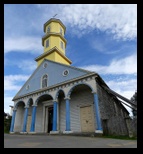
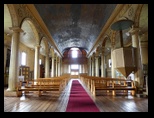
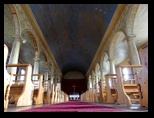
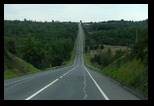
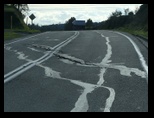
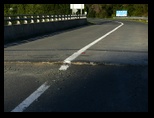
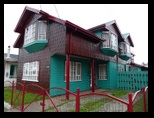
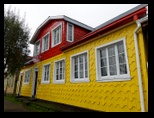
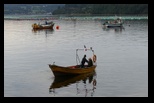
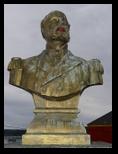
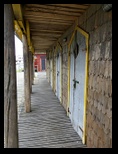
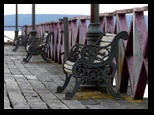


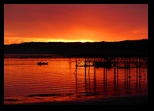
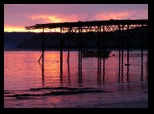
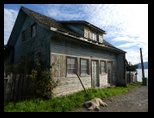
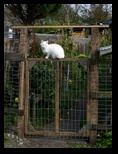
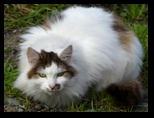

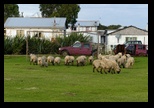
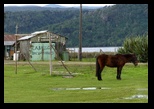
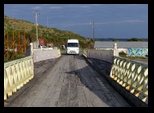
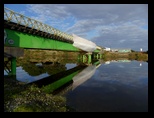
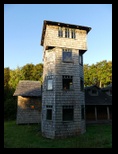

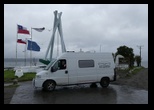
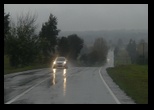
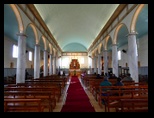
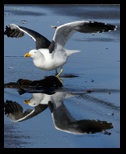
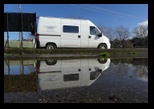
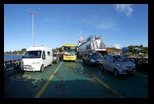
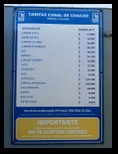
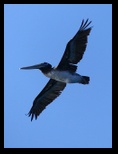
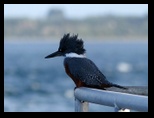
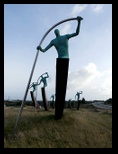
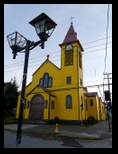

Click on a photo to enlarge it.
The weather looked good for the next three days so we sped off south along Ruta 5, through two tolls (1,900 and 700 pesos, about $4 in total) and got down to the ferry at Pargua. We only had to queue up for a few minutes and then drove straight onto the ferry. Even our GPS said "Board the ferry!"
The ferry journey only took 20 minutes across the choppy and windy channel to Chacao and we were charged 14,800 pesos ($23 US) for a Furgon Tourismo. The Camioneta price was 12,800 pesos but the small print said that was only up to 1.5 tonnes and we weigh 3 tonnes. It was a beautiful sunny day and the top temperature was 16 degrees - that's really good for the Chiloé Islands at this time of year.
Construction on the controversial Puente Chacao, a 2.6km suspension bridge - the largest of its kind in Latin America - linking Chiloé with the mainland, has already begun and is scheduled to be operational by 2020.
Lonely Planet states that "Isla Grande de Chiloé, the continent's fifth-largest island, is home to a fiercely independent seafaring people who developed culturally and historically in defiance of Santiago. Immediately apparent are changes in architecture and cuisine: tejuelas, the famous Chilote wood shingles; palafitos (houses mounted on stilts along the water's edge); the iconic wooden churches (16 of which are Unesco World Heritage sites); and the renowned meat, potato and seafood stew, curanto. A closer look reveals a rich spiritual culture that is based on a distinctive mythology of witchcraft, ghost ships and forest gnomes. All of the above is weaved among landscapes that are wet, windswept and lush, with undulating hills, wild and remote national parks, and dense forests, giving Chiloé a distinct flavour unique in South America.
Chiloé itself stayed off the radar until the 1850s when its proximity to the new Puerto Montt gave the islands increasing commercial importance. It took another century to establish a road running the length of the main island. Fishing was and is the main industry, but is now heavily dominated by salmon and shellfish farming. Tourism has increased significantly during the last two decades." (From Lonely Planet)
We know other travellers who have spent two weeks here but we would only get a few days and needed to make the most of them. The drive into Ancud, a town at the northern end of the island, was very bumpy for us as we still don't have new shock absorbers. The road was concrete plates that were badly broken in places.
We only stopped for a few photos and a coffee before heading south to the first church we wanted to see in Dalcahue. Nuestra Señora de Los Dolores was founded in 1849 and is one of the Unesco WH sites. Unfortunately it was closed! There used to be 150 wooden churches but now only about 60 remain on the islands.
We headed into Castro, 85km south of Ancud. The city sits on a bluff above its sheltered estuary lined with distinctive 'palafito' houses (houses on stilts). Castro is the best place to see them. From the street, they resemble any other house in town, but the backs jut over the water and, at high tide, serve as piers with boats tethered to the stilts. This truly singular architecture - technically illegal - can be seen along six areas in town. The earthquake in 1960 destroyed the port, the railway and the town hall as well as some palafitos.
Castro is the capital of the island and the largest "city" with a population of 41,600. There's also a large population of stray dogs and we managed to find a parking area where at least 9 came along to bark at us! I stayed with the motor home whilst Kirsten jumped out to take some photos. The parking lot we were on was listed on iOverlander as a place to stay for the night but there was no way we would stay here with all these stray dogs. So we drove through the city and then down an extremely steep slope to the estuary where there was a parking area across from a number of houses on stilts. It would be a bit noisy from all the traffic but at least there weren't any dogs!
Kirsten walked back into town to see the Iglesia San Francisco de Castro which was completed in 1912 to replace two previous churches that had both burned down. It's bright yellow with mauve trim on the outside and a varnished wood interior with stained-glass windows.
After a futile search for propane the next day we went back to the stray dog car park because we had missed some photos of houses on stilts! That's a real no-no for an avid photographer! I never did get to my walk around the city because we drove out and went to see three other churches - in Nercón, Vilupulli and Chonchi.
Afterwards we headed south east, off the main road and down to Queilén, a fishing port on the eastern side of the island. We parked in the main square and went for a walk. It had been mostly cloudy all day so we had a great sunset.
The sun came out the following day and we drove back to the main road which is still Ruta 5 and then turned off west to go to Chiloé National Park. The road had a lot of damage which may have been caused by earthquakes and one bridge had ended up with a step up to it which was particularly nasty for tyres. No speeding along this road that's for sure!
We took a coffee break next to a very quaint little church in Cucao and then drove to what was the end of the road for us - a very narrow bridge that was in the shape of a boat and didn't look like it could hold our weight. It was a gravel road on the other side anyway so we decided we'd turn around. We went back to the Ruta 5 and south but it was getting dark so we pulled off towards a fishing dock at Lake Natri. We just made it in time for the sunset and Kirsten jumped out before I'd even parked!
It rained the next morning but we hoped it would clear up. Despite the weather we decided to go down to the southern end of the island which was 72km further, to Quellón. It's touted as being the official southern end of the Panamerican Highway, one of the world's great highways, but most people believe Ushuaia in Argentina to be the end of the road. We were there last year so now we have been to both "ends" of the road!
We only stopped for a quick photo and a drink. It hadn't really been worth it to drive down here. We set off north again in the rain and stopped at a supermarket to pick up a few supplies. It took ages as the cashier was so slow. Then we got stuck behind a long queue of traffic heading out of the town. We realised there was a funeral cortège at the front with the mourners walking behind the hearse.
Out of respect no one overtook but at a traffic light they turned right and off the main road. (The hearse didn't bother to stop for the red light!) We went back up towards Castro through increasingly heavier rain. At one point the low clouds and fog meant visibility was down to only a few metres in front of us. It was really difficult to drive in such miserable weather because I needed to watch the road for bumps and potholes.
We got through the heavy traffic in Castro and went back to Dalcahue and parked near the church. It didn't stop raining all night and all the following day. This is normal weather for Chiloé and we didn't fancy driving up to the ferry so we stuck it out for the day.
We managed to get internet from inside our motor home to watch Hamburg play the penultimate match of the season. We had to switch on the engine to get enough power because there was no sun for our solar panel and we ran out of power. Then the internet connection went really bad in the very last minutes of the match and just as the opposing team seemed to have scored a goal which would have been the winner. But we couldn't tell and then all we saw was that the match had ended. But what was the score?!!
We frantically tried to get the internet connection back and eventually found out that the last goal was disallowed. So we drew and got a very important point that would save us from definite relegation. (Kirsten even cried!) We could still end up in the relegation play-offs so we're still in danger but that would be decided in the final match next week. Hopefully we can get to see it.
It was still raining the next day and Kirsten braved getting wet to go and see the church. We had been here 5 days ago when the church was closed but today was Sunday and Kirsten could get inside for a photo.
The rain finally cleared up and the sun came out. We drove, or should I say kangarooed, back up to Ancud. Good job there wasn't much traffic today. We had a coffee and filled up with diesel because it was cheaper than on the mainland. We drove the 28km back to the ferry and got straight on without waiting. This time we were only charged the car price! So it only cost us 12,200 pesos ($18-80 US) just over $4 US cheaper. Thanks!
Isla Grande de Chiloé
The return journey was a lot smoother and we noticed that our GPS showed one hour less. Has there been a time change? But it's the middle of May! Hmm! We didn't know and at some point we would have to ask. For the moment it didn't matter and we headed north, back along the Ruta 5, and turned off east to Calbuco to take a look at the church we'd seen in our Copec books. It was bright yellow and red and we had to drive up yet another extremely steep hill to get there!